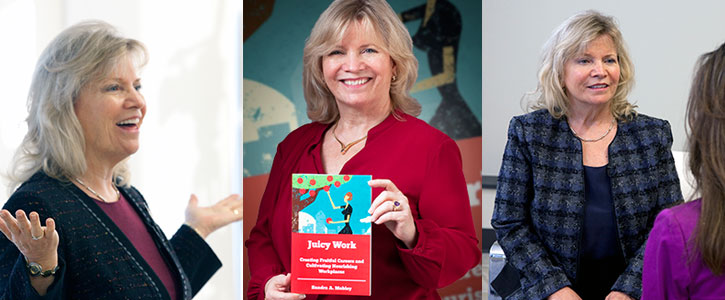SANDY MOBLEY
AUTHOR | SPEAKER | BUSINESS COACH

 What does “Juicy Work” mean to you?
What does “Juicy Work” mean to you?
Juicy work is awakening to the possibility of bringing all of your energy, passion, knowledge, and experience into your career. No matter what your background is or what field you are in, finding juicy work is possible. My clients have often said, “I want work like you have!” I want to make juicy work available to everyone.
Can you give an example of how you helped someone find their “Juicy Work” through coaching?
An organization’s most expensive executive hire was about to go out in flames. Tom was hired from Wall Street to strengthen their portfolios. While he hated the competitive environment of Wall Street, he was chaffing under the bureaucracy and causing turmoil with other executives as he made changes without talking to them.
Tom’s main concern was how to balance the portfolio where speed mattered and internal approvals were slow. For Tom to be competent and confident in his new role, his ability to show vulnerability and ask for help, while counter to his instincts, was critical for his success. I devised comfortable ways he could get to know his staff and learn what was important for success in his role. We identified people in the organization who would be good mentors and how he could ask for their support.
One of his intended mentors, the CFO, had asked him to lead the United Fund drive for the organization. He agreed and asked the CFO to mentor him. Tom showed his excellent influence skills in running the campaign. His mentorship from the CFO helped him learn the unwritten rules before he stepped on organizational land mines and helped him build stronger relationships with other members of the executive team.
When the organization’s sales weakened the following year, Tom’s management of the portfolios kept the company profitable. Moreover, the trust he had built with his colleagues ensured faster approvals for his investment decisions. He was doing the work he loved in an environment where he now was thriving.
How else have you used coaching?
As organizations grow, the values that define the culture can become diluted or even lost. The owners of a statistical consulting firm wanted to reinforce the values that had made them strong, e.g. collaboration and not letting ego get in the way of a good idea. We taught two cohorts of leaders within the company to coach each other and to ask questions instead of giving advice. Each cohort included an owner, several Vice Presidents, and three to four managers. Teaching them a new way of working together fostered positive change throughout the company, leaders built closer relationships, developed a greater understanding of the company values, and built a greater commitment to action.
How have you seen “Juicy Work” impact a whole organization?
I have seen pockets of juicy work in many organizations and have applied different solutions to help leaders create juicy workplaces. In some cases, we created skills assessments that allowed people to define their best work and then used that information to align them with jobs that were better fits. In another organization, we defined vision and values which motivated the workforce and increased their buy-in and commitment. Change takes time and requires on-going leadership attention to succeed.
What is it like for someone to work with you as a coach?
I tailor my coaching approach based on each person’s unique needs using a common framework. I like to begin by collecting data and feedback about the person. Next, I help my clients develop specific goals. I ask my clients, “What will that get you?” and “What will success look like?” to make sure the goal is aligned to what they really want, get them excited about the possibilities, and set a benchmark for how they’ll know when they’ve reached their goals. Most importantly, I help them identify and leverage their strengths and passions.
Clients report that they appreciate that I provide options and actions that they can apply to address their needs. For example, one introverted client had a difficult time speaking up in meetings. I suggested he prepare several comments related to the meeting topics ahead of time so he could speak ‘spontaneously’ in the meeting.
Can you tell us about your background?
I’ve spent much of my life on a personal quest for juicy work. I started my career in computer programming and technical marketing. Feeling burned out, I went to Harvard to get my MBA and find a different and more satisfying career thrust. After graduating, I worked for a few Fortune 500 companies leading executive development and organizational change—a great combination for my technical background and passion for people development. I then transitioned from organizational change to individual change and became a coach. I’ve now worked with over 2,000 leaders to help them find more fulfillment in their work, resulting in satisfied leaders and thriving workplace cultures.
